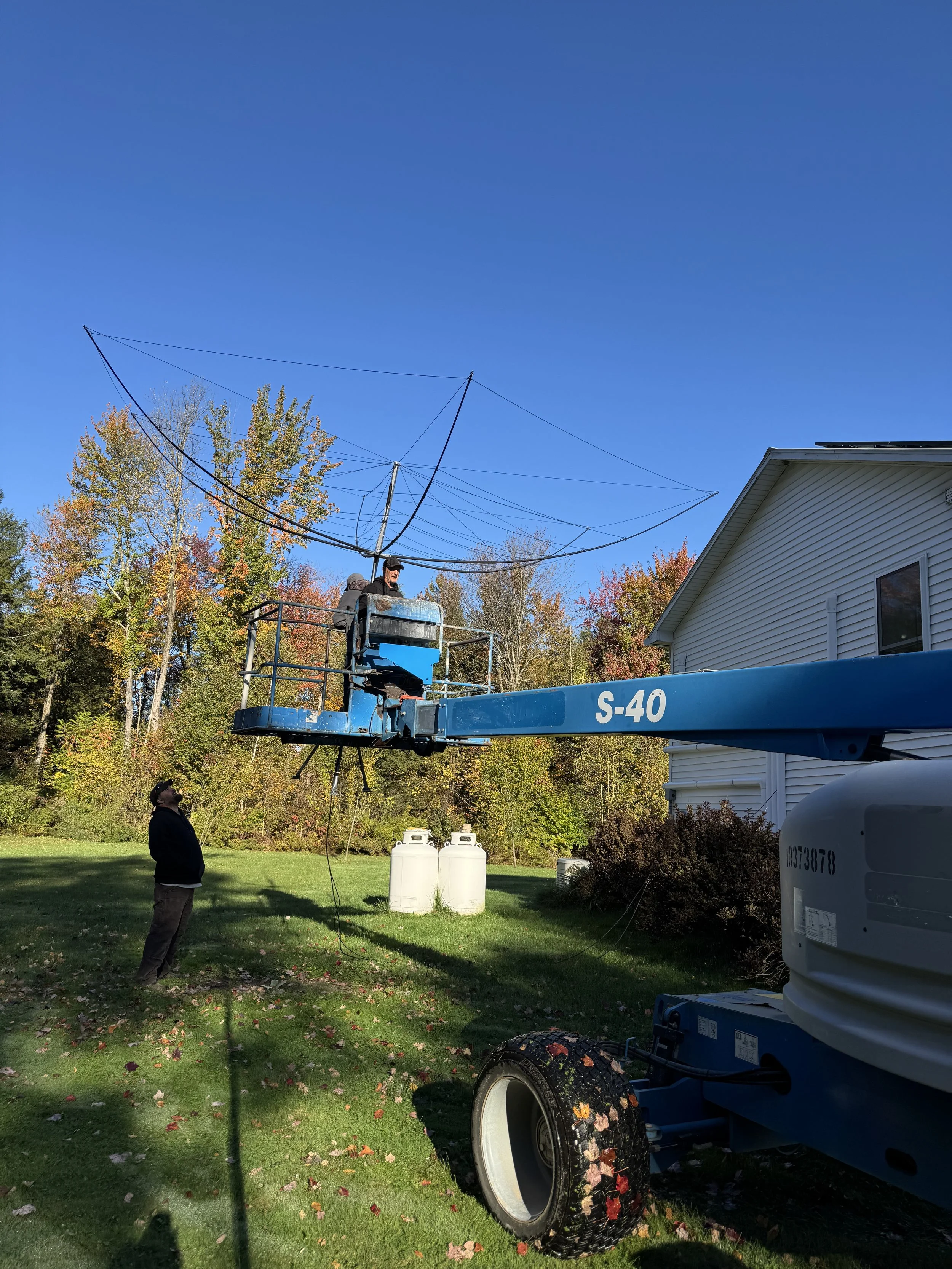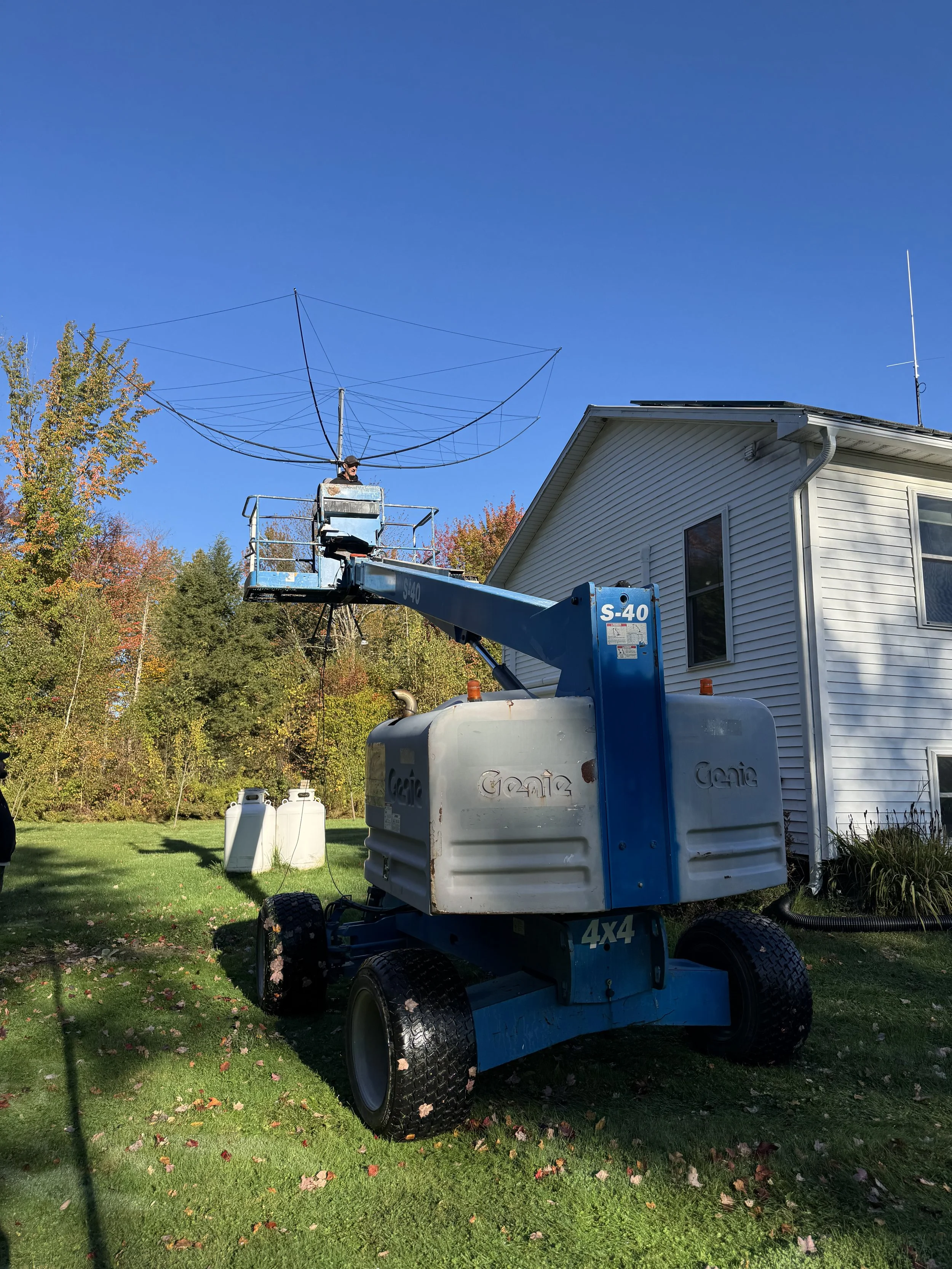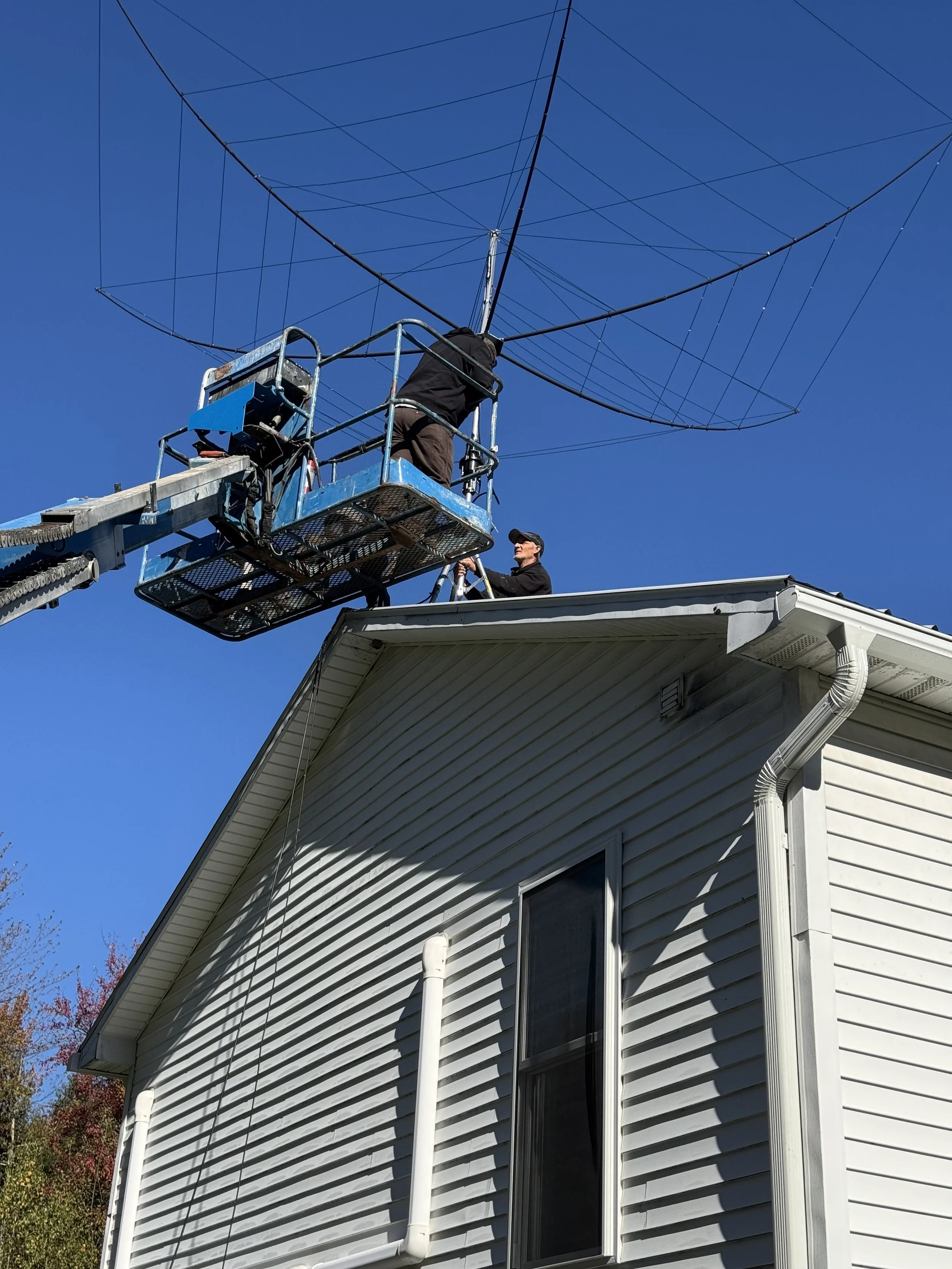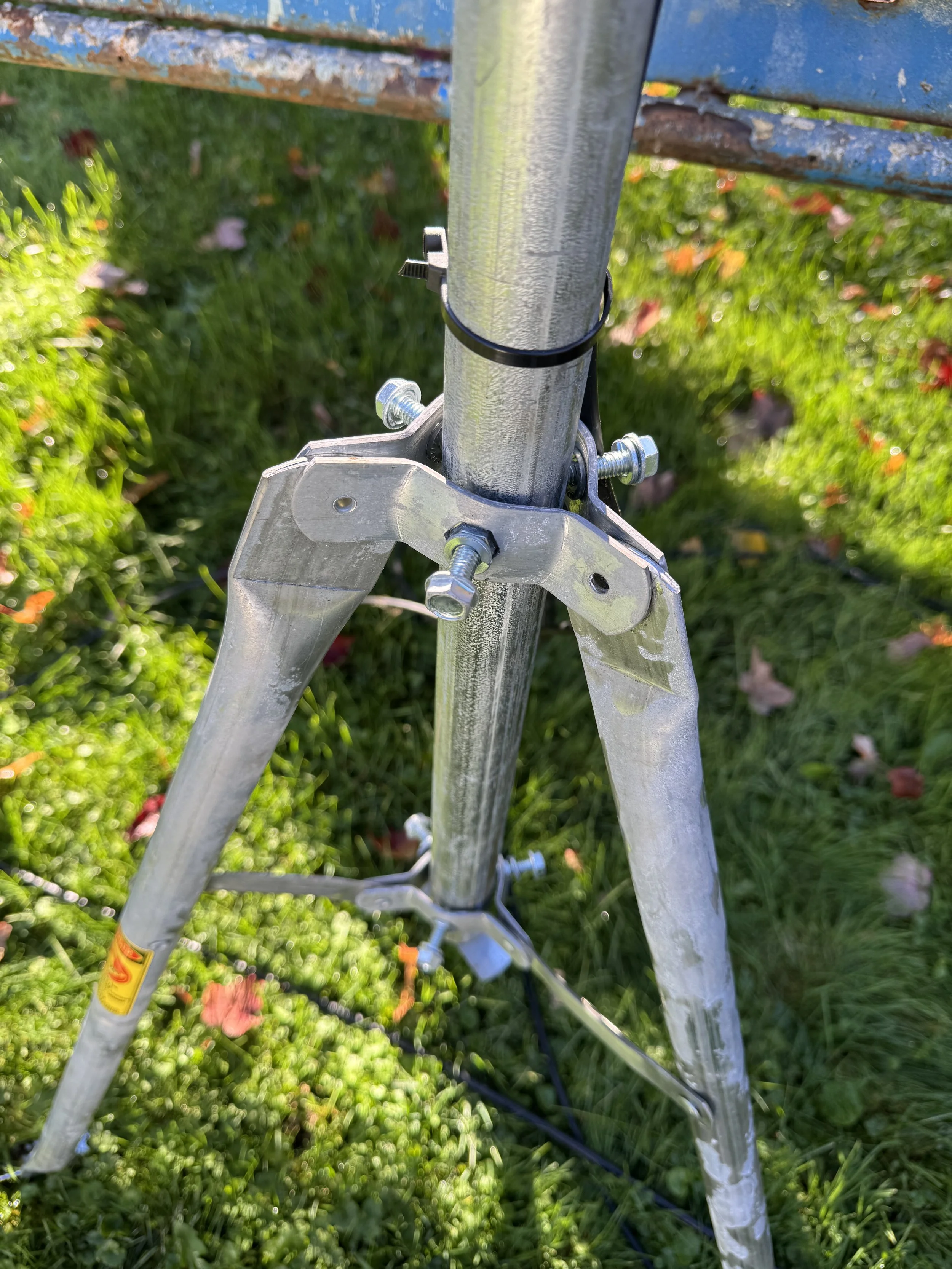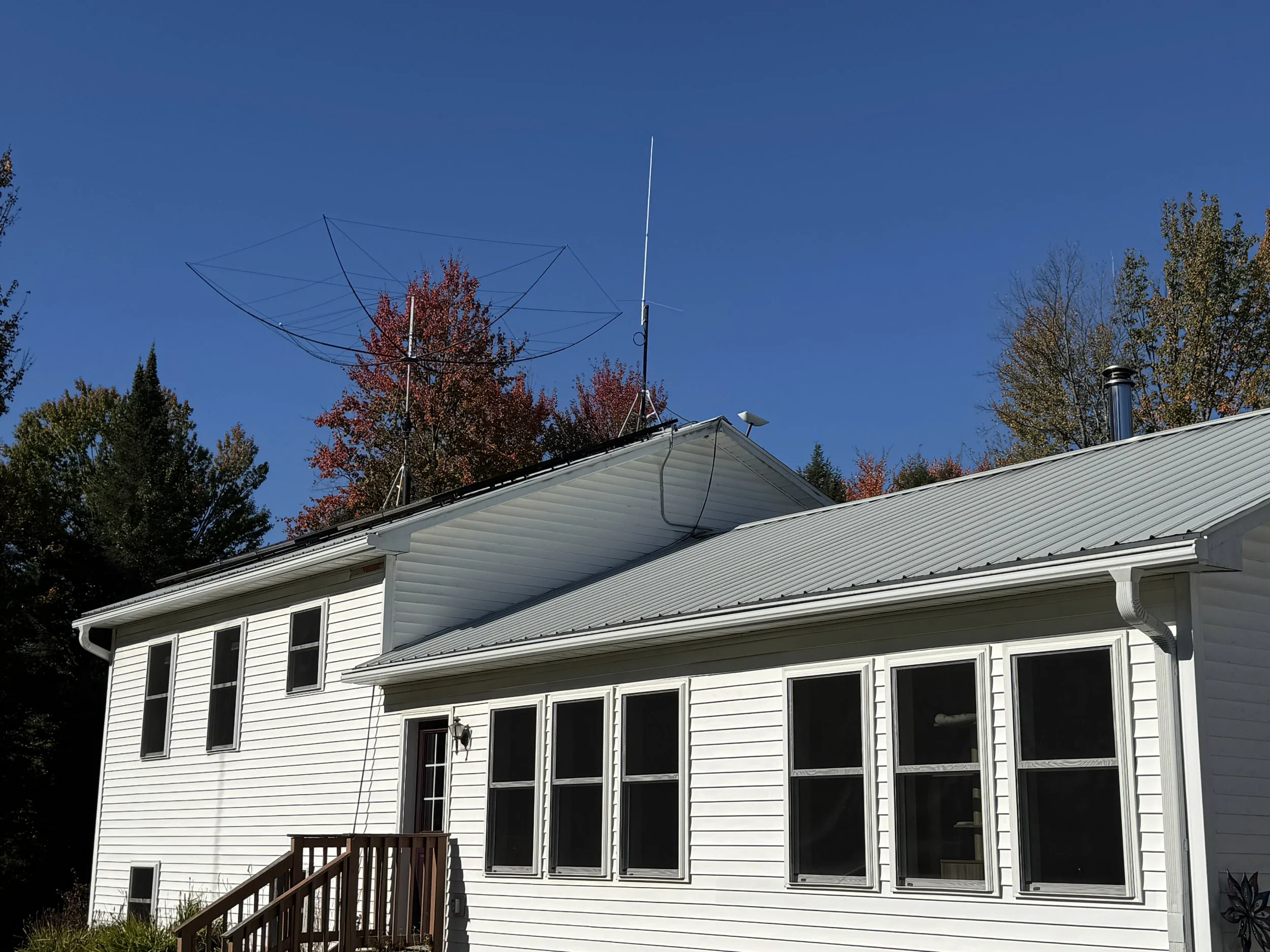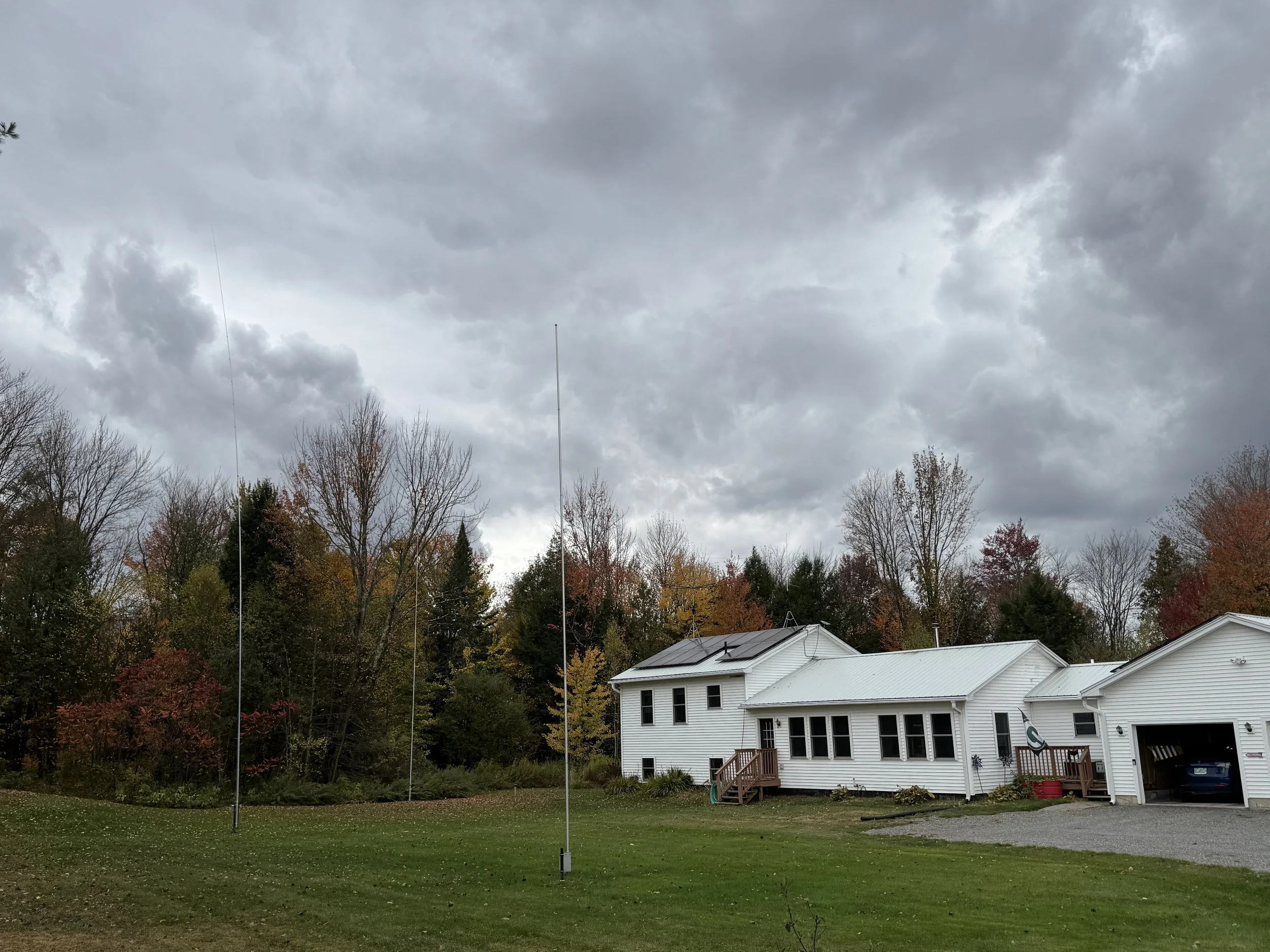Raising the NA4RR Hex Beam Antenna (+ Performance)
Here we go!
The approach to getting my hex beam antenna from the ground to the top of my tri-level house was straightforward: Assemble it entirely on the ground, then use a lift to raise it onto the roof in one piece.
The reasoning for this approach was that:
- Any issues with the antenna (construction, tuning, etc.) could more easily be discovered and fixed with the antenna on the ground.
- The people installing the antenna on the roof were roofing tradespeople (my roofer did the work), and I wanted it to be simple: get the tripod positioned and screw it down into the roof.
- Since this is a directional antenna, I placed the tripod exactly as it should be on the ground, with the antenna pointed North—no adjustments needed on the roof. Get it up there, place the tripod, and screw it down.
- While the antenna and rotor are only about fifty pounds, the antenna is bulky. If we were just to put an empty tripod on the roof and then attempt to get the mast and the antenna on it, the risk of something going (terribly) wrong was too high.
How did it go?
The initial attempt went well. And, yes, the *initial* attempt. Here is the lift taking the antenna to the roof. The lift has a cage or bucket. They lifted the antenna outside the bucket so they wouldn't have to lift it over the bucket (it's very unwieldy).
The person behind the driver has the antenna
They then, at my suggestion, lifted it until the base of the antenna tripod was just a few inches above the roof. The purpose was to move the antenna laterally without having to lift their arms over their heads. You lose leverage unless you move the antenna laterally.
Notice how the tripod is just above the roof. And the right leg of the tripod is the one marked to be pointing to the right so that the antenna points north.
And here is where Murphy, a.k.a. my Rohn Tripod, failed.
The Tripod failure
I had an issue with my tripod before raising day when I was putting it together on the ground. I took out the tripod, and when I put the antenna in, I then moved the whole antenna and tripod from some twenty feet from the house (so I could operate it while on the ground), close to the house and lift point to the roof.
And the rivets at the top of the tripod came straight out. The antenna was now held together on no base. The antenna came down, but I thought I had carefully let the antenna fall to the ground. When two spiders are held equal to the ground, they will absorb the weight of the antenna.
But I was off a bit. And all the weight of the antenna fell on one spider, and that fiberglass spider busted. This would not be unexpected.
Upon reflection, the top rivets were not installed well on the tripod. I noticed the butterfly at the end of the rivet didn't cover the opening as well as it should.
But better to have this happen well on the ground, as noted above. I ordered a new spider from NA4RR, prepped it, and put the antenna back together with help from my friend. In the meantime, I reordered another tripod from DXEngineering.
Antenna goes back into the tripod; all is well. Then lift day came.
The antenna reached the roof peak, as shown above. About 30 seconds after that picture was taken, my roofer said the rivets had busted, and we needed to take the antenna back off the roof.
Honestly, I was devastated. Because of my solar panels, there isn't much room to put a tripod. And all the pictures I saw on NA4RR's site showed this tripod holding up the antenna. Figuring out what new thing I would need to get would take time and cost money. Not to mention that it took over a month to get a lift for the job.
And in Vermont, you know, winter is coming.
The solution
This is what the tripod looked like when it got back on the ground:
Note the missing rivets. The tripod is held together by the bolts that go into the mast.
My roofer then suggested we drill out the rivets and replace them with bolts. A solution that could still be done that day!
I went to the hardware store, about five miles away, and procured four stainless steel bolts, washers, and nuts. The tripod, of course, takes only three, but I wasn't taking any chances.
I got back and we started the drilling and replacing. But it was no mean feat to move the mast around to get each tripod section to line up so we could insert the bolts and lock it down. It literally took all four of us to get that done. But the tripod is FAR stronger now, even if the rivets had been correct. We also checked the rest of the tripod to ensure there weren't other issues before getting the antenna back up on the roof.
And then, the antenna went back on the roof. Once we were done with the bolts, it only took about half an hour. Which is what it would have been if we didn't have the three hours before to get stuff up, down, fixed, and then up again.
Finally…
The NA4RR Hex Beam Performance
My roof's peak is about 18 feet high. That places the 20-meter wires at about 28 feet, and the bottom set of 6-meter wires at about 23 feet.
I also have a very good 'all band' vertical at 43 feet high with 60 radials, 40-65 feet long. With the other vertical antennas I have, there is 10,300 feet of copper buried in my yard. It's an excellent grounding system for the 'other half' of the vertical. This would be the antenna I would be comparing.
In the foreground is my 37-foot 40-meter vertical. To the left and back is my 67-foot 80-meter vertical. And between them, further back, is my 43-foot all-band 80-6 meter vertical. On the roof is the hex beam. You can really tell how much it is hidden with the black painted spiders.
SWR
The SWR across all bands is less than 1.5:1, and that 1.5 is on parts of the 6-meter band. The rest of the bands are 1.2:1 or less, with most flat.
Put another way, I was running 600 watts out on 20 meters the other day, and the reflected power was... 2 watts.
On the air
Working the pileups over the last couple of weeks has been a joy. I don't have the equipment to measure gain or front-to-back on the antenna, so all of this is my opinion.
I can tell you that I get through the pileups faster, I can hear stations with the hex beam that I cannot hear on my vertical (radials are excellent for *transmitting* but not receiving), and the number of 1-3 calls to break a pileup is much higher with the hex beam.
In addition, I can take a given call, and when I point the beam at that station, it is significantly louder than if the beam is pointed away or to the side of the station. Sometimes, depending on conditions, from not hearing the station to Q5 copy with the beam pointed in the right direction. So front-to-back and gain are real things with this antenna.
When I switch between vertical and hex beam, the hex beam outperforms the vertical by 3-6 S-units. It shouldn't be that way, given the hex beam is like a two-element beam, but that's what happens at my station.
Conclusion
If this antenna had worked along the 'happy path' instead of the issues I ran into putting the antenna together, and then installing it on the roof (this article), this antenna would have been a breeze to put together and get installed.
Regardless of the issues I had, I'm very pleased with the NA4RR hex beam antenna - it fits my needs for a directional antenna I can put on my roof instead of the expense of a tower, delivers performance gains, and lets me operate 20 through 6 meters on one antenna.
